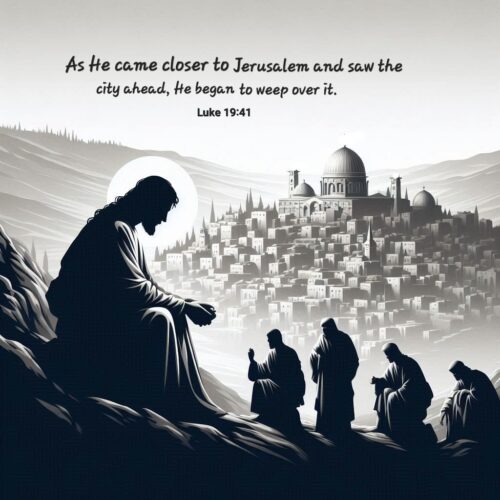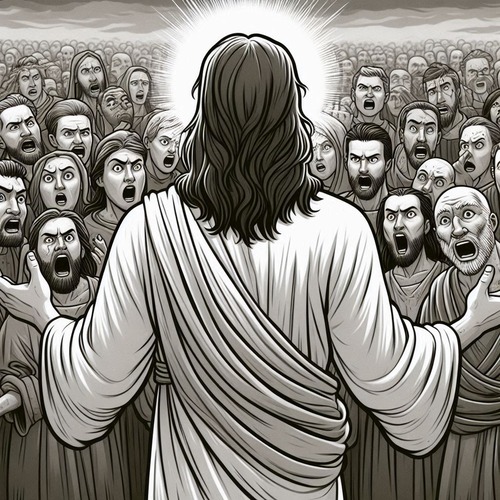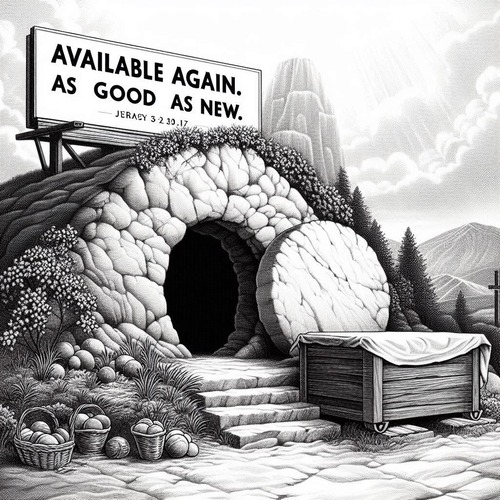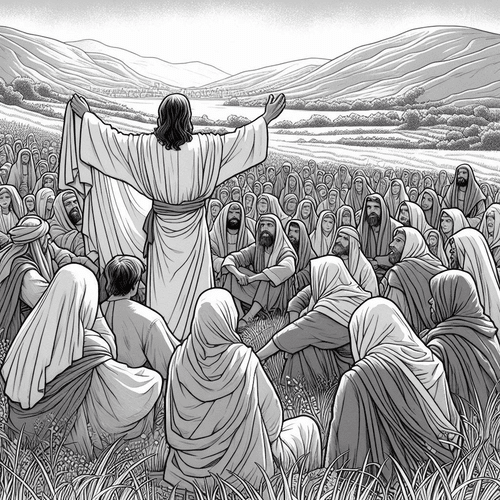The Fall of Jerusalem: How History Confirms Jesus’s Prophecies
The haunting words of Jesus Christ echoed through Jerusalem’s streets around 30 CE: “Not one stone here will be left on another; every one will be thrown down” (Matthew 24:2). Within a generation, these prophetic words would find their fulfillment in one of history’s most dramatic sieges. The destruction of Jerusalem in 70 CE stands as a pivotal moment in redemptive history, demonstrating both the divine foreknowledge of Christ and the transition between the Old and New Covenants.
UNDERSTANDING THE CONTEXT OF CHRIST’S PROPHECIES
As Jesus and His disciples departed from the Temple, they marvelled at the magnificent structure before them. Herod’s Temple was indeed a wonder to behold. Its massive white stones, some measuring 40 feet in length, gleamed in the sunlight. Gold plates adorned its façade, and even Roman historians praised its grandeur. The disciples’ amazement makes Christ’s prophecy all the more shocking—this seemingly indestructible edifice would be utterly demolished.
The setting of this prophecy, known as the Olivet Discourse, carries deep significance. Seated on the Mount of Olives, overlooking the Temple complex, Jesus delivered some of His most detailed prophetic teachings. The location, directly east of the Temple, provided a panoramic view of the very structure whose destruction He foretold.
DETAILED ANALYSIS OF SPECIFIC PROPHECIES AND THEIR FULFILLMENT
The Signs Leading to Jerusalem’s Fall
False Prophets and Messiahs: Christ began by warning of false messiahs, a prophecy dramatically fulfilled in the years leading up to Jerusalem’s destruction. Josephus records numerous false prophets and messiahs who led people astray. He specifically mentions Theudas, who promised to part the Jordan River, and the “Egyptian false prophet” who gathered thousands of followers on the Mount of Olives—precisely where Jesus had delivered His warning.
Wars and Rumours of Wars: The predicted “wars and rumours of wars” materialised In the Roman civil wars of 68-69 CE, known as the Year of the Four Emperors. During this period, four different men claimed the imperial throne, creating unprecedented political instability. Simultaneously, Jewish revolts erupted across the empire, from Alexandria to Cyrene.
Famines and Earthquakes: Jesus’s prophecy of famines and earthquakes found fulfillment in the widespread food shortages during Claudius’s reign (41-54 CE), documented by both Roman historians and the book of Acts. Significant earthquakes struck the region, including a major tremor in Laodicea in 60 CE.
The Siege of Jerusalem: Luke records Jesus’s specific prediction that armies would surround Jerusalem (Luke 21:20). In 70 CE, Titus led four Roman legions in encircling the city with a siege wall, exactly as prophesied. Josephus provides detailed accounts of this siege in his “Jewish War,” describing the construction of a circumvallation wall that completely isolated the city.
A Great Tribulation: The “great tribulation” Jesus foretold manifested in unprecedented suffering during the siege. Josephus records mothers resorting to cannibalism, civil war between Jewish factions within the walls, and deaths numbering in the hundreds of thousands. His description of the suffering aligns precisely with Christ’s warning that it would be unequalled in history.
HISTORICAL DOCUMENTATION OF THE FULFILLMENT
Josephus serves as our primary historical source for these events. As a Jewish historian who witnessed the siege firsthand, his account provides crucial corroboration of the prophetic fulfillment. He describes the total destruction of the Temple, with Roman soldiers prying apart the massive stones to extract melted gold—literally fulfilling Christ’s words that no stone would be left upon another.
Additional confirmation comes from Roman historians. Tacitus, in his “Histories,” confirms the basic outline of events. Archaeological evidence, including the siege ramp at Masada and the burnt layers in Jerusalem’s excavations, provides physical confirmation of the historical accounts.
ARCHAEOLOGICAL EVIDENCE CONFIRMING BIBLE PROPHECIES
- Not One Stone Left Upon Another (Matthew 24:2): The massive stone blocks discovered at the Western Wall excavations lie precisely where they fell when Roman forces toppled the walls. These stones, weighing up to several tons each, were systematically dislodged and pushed down, leaving clear archaeological evidence of the systematic destruction Jesus predicted.
- Total Destruction by Fire (Luke 19:44; Matthew 22:7): A uniform destruction layer about 1 meter thick has been found throughout Jerusalem, containing burnt wooden beams, ash deposits, and melted stone and metal objects. The intense heat required to melt stone confirms the Biblical prophecy of the city being burned, with the destruction layer’s consistency showing how thoroughly the Romans fulfilled Jesus’s words.
- Signs of Military Encirclement (Luke 19:43): Archaeological discoveries of the Roman siege wall, including the recently discovered “Third Wall” mentioned by Josephus, confirm Jesus’s prediction that enemies would “set up ramparts around you and encircle you.” The finds include Roman ballista balls, arrowheads, and siege equipment exactly where Jesus said the encirclement would occur.
- Evidence of Great Tribulation (Matthew 24:21): The “Burnt House” excavation in the Jewish Quarter provides dramatic evidence of the severity of destruction, including human remains and valuable possessions left behind. This confirms the prophecy of unprecedented tribulation, showing evidence of panic, rapid abandonment, and massive loss of life.
- Destruction of Both Temple and City (Luke 19:44): Archaeological evidence shows the destruction extended far beyond the Temple, with excavations revealing systematic demolition throughout Jerusalem. The widespread destruction layer proves the fulfillment of Jesus’s prophecy that the entire city, not just the Temple, would be levelled.
- Timing Within One Generation (Matthew 24:34): Coins found in the destruction layer date precisely to the Jewish Revolt (66-70 CE), confirming the fulfillment occurred within the biblical generation time frame of 40 years. The numismatic evidence provides exact dating that aligns with Jesus’s prophecy about timing.
The archaeological evidence demonstrates:
- The totality of the destruction, confirming Jesus’s prophecy that no stone would be left upon another
- The intensity of the siege, validating accounts of the “great tribulation”
- The precise timing of events, confirming the prophecy’s fulfillment within one generation
- The historical reliability of both biblical and extra-biblical accounts
THEOLOGICAL SIGNIFICANCE
The destruction of Jerusalem carries profound covenantal implications. The end of the Temple system marked the definitive transition to the New Covenant era. The physical Temple’s destruction demonstrated its purpose had been fulfilled in Christ, the true Temple (John 2:19-21).
The destruction of Jerusalem is an event that serves as powerful apologetic evidence for Christianity. The precise fulfillment of Christ’s detailed predictions validates His prophetic office and demonstrates divine inspiration. The early church understood this, as evidenced by their flight from Jerusalem to Pella in response to Jesus’s warnings—a move that preserved the believing community.
CONCLUSION
The destruction of Jerusalem is a testament to the truthfulness of Christ’s words and the sovereignty of God in history. The precise fulfillment of these prophecies strengthens our confidence in Scripture and deepens our understanding of God’s redemptive purposes. As we study these events, we see not just the end of an era, but the confirmation of the New Covenant and the faithfulness of our Lord’s promises.
THE FALL OF JERUSALEM—RELATED FAQS
How did the timing of Jerusalem’s fall align with Jesus’s prophecy about “this generation”? Jesus predicted the Temple’s destruction would occur within the generation hearing his words (Matthew 24:34). This was dramatically fulfilled when Jerusalem fell in 70 AD, roughly 40 years after His prophecy. This timing aligns perfectly with the biblical concept of a generation and occurred while many who heard Jesus’s original prediction were still alive.
Why did Jesus tell His followers to flee when they saw Jerusalem surrounded by armies? Jesus gave specific instructions for believers to flee when they saw Jerusalem encircled (Luke 21:20-21). Historical records show Christians in Jerusalem heeded this warning and escaped to Pella when Roman armies temporarily withdrew in 68 AD. This unexpected withdrawal created a crucial window for escape that saved many lives.
Did any Jews survive the Temple’s destruction, as prophesied? Jesus indicated there would be survivors who would be “led away captive into all nations” (Luke 21:24). Josephus records that about 97,000 Jews were taken captive and dispersed throughout the Roman Empire, while others fled to various regions, precisely fulfilling this prediction of Jewish dispersion.
How did the Temple’s destruction end the sacrificial system as predicted in Daniel? Daniel 9:27 prophesied that sacrifices would cease, and Jesus’s predictions about the Temple’s destruction showed how this would happen. The Temple’s demolition permanently ended the biblical sacrificial system, as it has never been restored in the 2,000 years since, fulfilling both prophecies.
Were there really signs in the heavens before Jerusalem’s fall? Jesus predicted there would be signs in the sun, moon, and stars (Luke 21:25). Tacitus and Josephus both record unusual celestial phenomena during this period, including a comet resembling a sword that hung over Jerusalem for a year and strange lights around the Temple.
How detailed was the Temple’s destruction compared to Jesus’s words? Jesus said not one stone would be left upon another (Matthew 24:2). Titus actually tried to preserve the Temple, but his soldiers, seeking to retrieve melted gold, dismantled it stone by stone—exactly as Jesus had said, even though such complete destruction would have seemed unlikely.
Why does Josephus’s account matter so much for validating these prophecies? Josephus was a Jewish historian who witnessed the siege firsthand and had no interest in proving Jesus’s prophecies true. His detailed account, written shortly after the events, provides unbiased confirmation of how events unfolded exactly as Jesus predicted, making his testimony particularly valuable for apologetics.
THE FALL OF JERUSALEM—OUR RELATED POSTS
Editor's Pick

The Throne-Room Vision: Who Did Isaiah See?
The scene is unforgettable: Isaiah stands in the temple, and suddenly the veil between heaven and earth tears open. He [...]

The Angel of the Lord: Can We Be Certain It Was Christ All Along?
Throughout the Old Testament, a mysterious figure appears: the Angel of the LORD. He speaks as God, bears God’s name, [...]
SUPPORT US:
Feel the Holy Spirit's gentle nudge to partner with us?
Donate Online:
Account Name: TRUTHS TO DIE FOR FOUNDATION
Account Number: 10243565459
Bank IFSC: IDFB0043391
Bank Name: IDFC FIRST BANK






